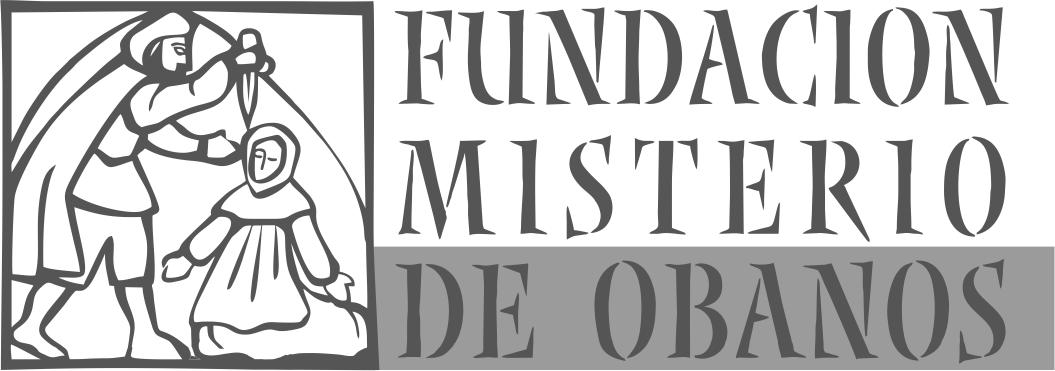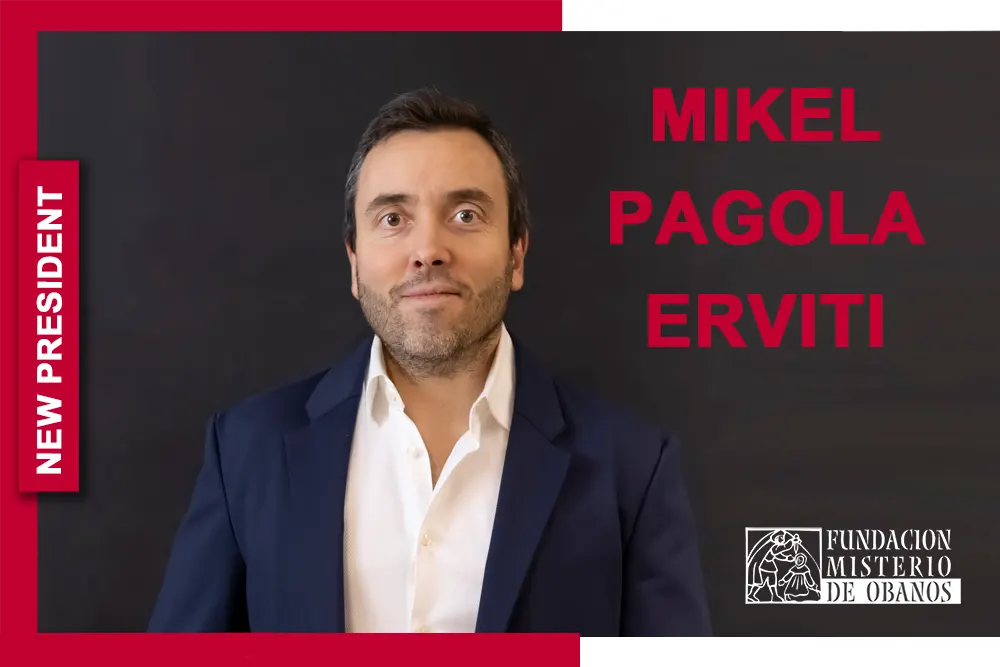The new president of the Mystery of Obanos Foundation will propose to the town a modernisation of the work but based on the original texts.
Mikel Pagola Erviti is the new president of the Misterio de Obanos Foundation, the legal entity in charge of organising the performances of the largest theatrical work in Navarre, known as “Misterio de Obanos” and whose full name is “Misterio de San Guillén y Santa Felicia”. In addition to the theatrical work itself, the Foundation’s heritage includes more than a thousand medieval and Renaissance costumes that make up its valuable wardrobe.
On 21 November 2024, by unanimous vote of its members, the Board of Trustees of the Misterio de Obanos Foundation ratified the election of the new president previously made, by statutory order, by the Hermandad de Ermitaños de Arnotegui de Obanos (Brotherhood of Hermits of Arnotegui de Obanos) on 14 September. The Board of Trustees of this foundation is made up of the Department of Culture of the Government of Navarre, the Archbishopric of Pamplona, the Town Council of Obanos, the Parish Church of San Juan Bautista de Obanos, the Brotherhood of Hermits of Arnotegui, the associations of the Pilgrims’ Route to Santiago of Navarre-Pamplona and of Estella, the University of Navarre and two relevant members of the Board of Trustees, the University of Navarre and two relevant members of the field of Art and Culture of Navarre, currently Román Felones, ex-councillor of Education, Culture and Sport of the Government of Navarre, and David Gálvez Pintado, representing the Pamplona Chamber Choir.
Pagola has succeeded Arantxa Hernández Lacalle, mayoress of Obanos, who held the post on an accidental basis between February and November 2024, after taking it over due to the sudden death of Juan Manuel Rubio Guembe in January last year. Rubio presided over the Foundation in a first term between 1998 and 2005, and in a second term from 2020
The first staging of the Mystery, based on a medieval legend, took place in 1965, promoted by the Obanese priest Santos Beguiristáin, who was also its scriptwriter. And the last times it was performed were in 2008 in its original large format in the Plaza de los Fueros in this town in Valdizarbe, and in 2015 in a much smaller size, inside the parish church.
The new president’s vision for the future
Mikel Pagola was elected announcing his intention to propose a change of direction regarding the future of the Mystery. Firstly, he will hold ‘a series of participative reflection sessions with the people of Obanos to analyse the pros and cons of recovering and maintaining the Mystery, and to find out if there really is still a sufficient emotional attachment on the part of the residents of Obanos with respect to this large-scale and spectacular work’ that was performed in the heart of ‘the village of the Infanzones’. He also wants to get the other towns in the valley more involved “because I believe that the Mystery is such a big event that it should be a pole of attraction for the participation of the rest of the towns in Valdizarbe, and a driving force for the promotion of creative expression. I advocate, to a certain extent, that we should join forces by joining forces in auzolan”.
And after the projects of recent years, centred mainly on changing the text of the performance from verse to prose, which did not come to fruition, Pagola, with his arrival as president of the Foundation, intends to recover a large part of the original text, although reconverting it: “I propose an “aggiornamento” of the work and a rearrangement of it to tell the story of Felicia and Guillén in a more attractive and modern way, more linear and easier to understand for today’s audience. Although in essence the Mystery remains the same, a colourful choral ensemble thanks to the participation of hundreds of people, I believe that the Mystery must become an even more spectacular and aesthetically avant-garde event, but realised, as far as possible, by the people of Obanos using their own scenographic means”.
‘I also believe that today the play should focus on an aspect that has not been given importance until now, but which I think is crucial because it clearly underlies the story: it is what today we could call the “feminist” vision of Felicia, in the middle ages, who chooses to live her life as her heart, her conscience, and her self-chosen freedom dictate, which in her case is to withdraw from the worldly noise and be a servant to the most needy’. To this end, Pagola proposes that the first half of the play, centred on the journey to Santiago, ‘is starred linearly and entirely by Felicia as she coincides and interacts with other characters of the Mystery on the Camino, in a physical, spiritual and conscientious evolution that will “convert” her in every sense’.
Pagola proposes ‘eye-catching novelties and more spectacular props designed especially for Obanos, which will once again make it attractive to come to Obanos to see the “new Mystery”, a work that can only be seen in its magnificent monumental ensemble that serves as a great architectural backdrop’.
“And, above all, I would like that whoever today might not be concerned with the Mystery because of its original religious or symbolic charge, can now, in the new version that I propose, be interested in this new re-reading and in the cultural macro-event itself, which in the past was so dynamic for the village of Obanos in its day. And whoever wants to relive the legend of Guillén and Felicia alone, should continue to have it, based on the original verses by Manuel Iribarren Paternáin and Alfonso Ventura Vázquez, which I believe should be saved because they are a jewel, and because they are still recited by many people in Obanos on a daily basis, and that cannot be lost. Many people know the best texts of the Misterio de corrido, and they survive today, forming a collective memory of Obanos with a very important value of cultural cohesion”.
Pagola’s relationship with the Mystery of Obanos
Pagola, born in 1977 in Pamplona, holds a degree in Fine Arts from the Polytechnic University of Valencia. He completed his primary studies at the Francisco de Jaso Ikastola in the capital of Navarre. He began his high school studies at the Ikastola San Fermín (Zizur) and finished them at the School of Arts and Crafts in Pamplona, where he was one of the first graduating classes of the Artistic Baccalaureate when this model was introduced in Navarre. He is closely linked to Obanos because he has spent his summer holidays there since his childhood, and has family and friends in the town.
In 1998 and 1999 he created two multimedia shows on the façade of the church of Obanos under the common name of ‘Initium’, with which he began to experiment first-hand with artistic expression in large format and, especially, in his own words, ‘with the powerful plasticity of pyrotechnics combined with light, sound and other scenographic montages’. In fact, one of the most striking elements that Pagola created for his own compositions was later incorporated into all the performances of the Mystery of Obanos since 1999 by the stage directors of the different editions. This was the sudden lighting, all over the square, of fire pits with natural fire at the moment when Guillén entered at a gallop in search of his sister, Felicia, giving this moment greater visual drama.
In fact, Pagola was a member of the technical staff of the play with all the stage directors that the Mystery has had in its full-format performances staged in the Plaza de los Fueros in Obanos since 1999, being responsible for the fireworks effects and pyrotechnic shots in the editions directed by Josu Garín (1999), Alfonso Segura López de Dicastillo (2000, 2002 and 2006), and Javier del Cura Termiño (2004 and 2008).
Your first contact
But Pagola, before 1993, had already collaborated for several years in maintaining the costumes of the Mystery by helping the creator of the play, the Obanese priest Santos Beguiristáin Eguílaz, during the years when the play was no longer performed (1978 and 1998). “When, as a child, I found out that the old pilgrims’ hospital in Obanos still treasured the more than a thousand costumes that still make up the costumes of the Mystery, and that the scriptwriter and creator of this great event, “Don Santos”, was still alive, I sought him out to find out how and why he had put on the Mystery between 1962 and 1965. And as a result of that first visit, I fell in love with a play that I had only seen in photos, with its enormous format, with the importance it had for the town of Obanos, and I began to help him with the maintenance of the costumes, changing the covers of the different costumes, keeping track of the fabrics so that they didn’t moth over, repairing props, etc”, Pagola recalls.
The first revival was in 1993, the year in which Joaquín Corcuera Arenas took it up again as part of the Festivals of Navarre. ‘In that edition, with the revival of the Misterio and where its second period began’, Pagola explains, “I was in charge of the costume distribution, and I still keep the receipts I invented for it. It was my first Misterio, in which I took part as a mere figurehead, where I would appear at a given moment as a mazonero or builder, accompanying Don Santos”.
Currently, and since 2016, he is the artistic director of the San Fermín International Signature Fireworks Competition, although he has been collaborating with Pamplona City Council as a specialist in the organization of San Fermín fireworks since 2000, the year the international competition began.
Although until now he has only been involved in the world of large-scale shows, in the field of pyrotechnics, becoming president of the Misterio de Obanos Foundation will be the first time he will manage an event related to the performing arts.

